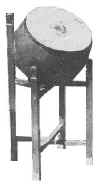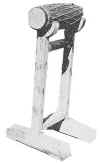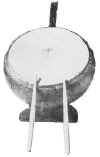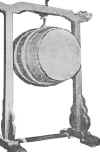
 | Dan Nhat: A five strings and short, slender
fingerboard instrument with unequal frets which allows extreme modulations. |
|

 | Sinh Tien: An instrument consisting of jingling
disks that are fitted onto a 2" W X 12" L wood piece. It is shaken with one hand
and struck with the other. Often used in the plural. They are used in the Bat Am (Royal
Orchestra). |
|

 | Cai Bong: A percussion consisting of a hollow vase
shaped sound-body with a membrane stretched tightly over one end strained by a system of
strings which are fastened at the swelling of the sound-body, played by beating with the
hands or sticks. |
|

 | Dan Tranh: A 16-21 string zither composes of a
flat sound box with strings stretched over it and played horizontally with the fingertips
or a plectrum. Similar to the Chinese tcheng, strings are supported by movable
wooden bridge for tuning. Size: 38" L X 6" W (small end) X 8" W (big end) |
|

 | Chap Cha
|
|

 | Trong Ba Bong |
|

 | Dan Bau: An acoustical instrument consisting of a
sounding box with one string and a movable bridge, used to study musical tones. The
instrument's single string stretchs over a trapezoidal wood soundboard. The soundboard is
made of the hard rind of the bau (type of gourd). Subtle ornamentations, glissandi
sounds, and imitation of the human voice could be produced by simultaneously plucking the
string and pulling the ancient whammy bar. The whammy bar is a flexible
bamboo stem which attachs to one end of the soundbox. |
|

 | Dan Co: A fiddle played with a bow, having 2
strings tuned at intervals of a fifth, an unfretted fingerboard, and a pipe-bowl-shaped
sound-box. It is capable of great flexibility in range, tone, and dynamics. There are 3
holding positions: The cornet is presses against the musician's hip as he/she walks. The
wooden resonant box is held between the musician's knees sitting on a stool. The cylinder
is held between the musician's feet in sitting position. Dan Nhi is called Dan Co
in South Viet Nam. |
|

 | Dan Gao: Slightly bigger than the Dan Nhi with
hemispherical resonance box made of coconut. Its sweet sonority resembles that of cello.
Same holding positions as of Dan Co. |
|

 | Dan Tam has 3 strings, keyless/fretless
fingerboard and ivory capotasto. The neck and cylindrical sound-box are typically
decorated/covered with snake skin. |
|

 | Dan Nguyet: A 2-string with name refers to shape
of the sound box. Unlike the Chinese yue'k'i`n, Dan Kim has long, slender
fingerboard with unequal frets which allows extreme modulations. Similar to the Cambodian chapey
deng veng. |
|

 | Dan Ty Ba: A four-string. It has a pear-shaped
body and a neck with a fretted fingerboard that is usually bent just below the tuning
pegs. Similar to the Chinese P'i P'�. Size: 37" L X 9-1/2" W. |
|

 | Dan Day is used to accompany the A-Dao
(professional singers) in North Viet Nam. |
|

 | Dan Sen is a 2-string, 14 keys instrument. It is
only used in the Hat Boi (Traditional Drama) in South Viet Nam. |
|

 | Trong Nhac: Trong Nhac consisting of Trong Cai
(female) or Trong Vo (military) and Trong Duc (male) or Trong Van (civil). The Trong Duc
has lower range. Size: 15" DIA. |
|

 | Trong Com: Trong Com is tuned by a piece of cooked
rice paste glued at the center of the membranes. Size: 8" DIA. (center) 6" DIA
(ends); 15 to 21" L. |
|

 | Dinh Nam: The Dinh Nam comes from the people of
Ede. Similar to a Pan Pipe. |
|

 | Mo: The Mo is made of scooped wood, played by
striking with a wooden stick to scan prayers. |
|

 | Ken: The Vietnamese oboe is a slender woodwind
with 6 holes, a conical bore and a double reed mouthpiece, having a range of three octaves
and a penetrating, poignant sound. There are 2 kinds of Ken: Ken Trung (big) and Ken Tieu
(small). Size: 18" L (former) ; 6" (latter). |
|

 | Ong Sao: A high-pitched woodwind instrument
consisting of a slender tube closed at one end with keys and 6 finger holes on the side
and an opening near the closed end across which the breath is blown. Ong Dich includes 1
supplementary hole close-off by a membrane of paper between the blowing end and the 6
finger holes. |
|

 | Luc Lac: String of Globular Bells |
|

 | To Diep: To Diep is made of Buffalo horn. It comes
from the Bahnar people. |
|

 | Mo Sung Trau: The Mo is made of scooped
Buffalo-horn, played by striking with a wooden stick. Size: 6 to 9" L |
|

 | Trong Lenh |
|

 | Phach Bang: A rhythm instrument consisting of a
pair of ivory, bamboo or hardwood, and clapped together with the hands. Often used in the
plural. It is called Song (2) Lang (bamboo) in South Viet Nam. Size: 2" THK X 10 to
12" L. |
|

 | Tam Am: Set of 3 connected tuned gongs that are
played by beating with a felt-covered hammer or stick used in a Nha Nhac (Royal Music
Orchestra). |
|

 | Bien Chung: A portable set of 12 bells tuned to
the chromatic scale and played with 2 light hammers. |
|

 | Chuong Gang: The Gang Bell is made of cooper,
played by striking with a mallet at the beginning of the Khai Kinh. |
|

 | Trong Chien |
|

 | T'rung: A wooden percussion with xylophone-like
sound. It comes from the Tay Nguyen region. |
|

 | Trong Co: The great drum consists of a hollow
cylinder or hemisphere with a membrane stretched tightly over one or both ends, played by
beating with sticks. In Traditional Drama Orchestra, the Dai Co is used to accentuate the
well-sung passages of the singers. |
|

 | Chuong: The Great Bell consists of a hollow metal
vessel set into vibration by a blow from a clapper within or a hammer without. Apparently
originating in Asia, bells have been used in connection with all major religions except
Islam. |
|